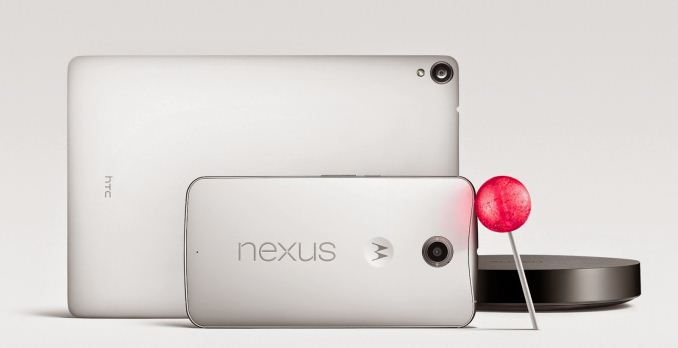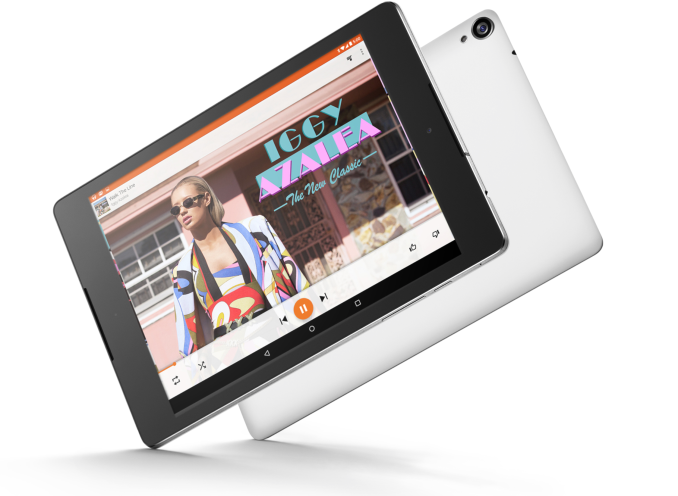Google Announces the Nexus 6 and Nexus 9 Running Android Lollipop
by Brandon Chester on October 15, 2014 12:33 PM EST
Today Google has officially announced the newest devices in the Nexus line, just one day before Apple's October event. Both devices have been rumored for some time now, and this is the first time in a while that we've seen Google introduce a new smartphone and tablet at the same time. The first device in the announcement is the Nexus 6, made by Motorola. The second is the Nexus 9 tablet made by HTC. To give an overview of how both devices look on paper, I've put together their specifications in a chart below.
| Nexus 6 | Nexus 9 | |
| SoC | 2.7GHz Snapdragon 805 (APQ8084) with 4 x Krait 450 + Adreno 420 at 600MHz | 2.3GHz 64-bit dual core Tegra K1 Denver SoC |
| RAM/NAND | 3GB LPDDR3 + 32/64GB NAND | 2GB LPDDR3 + 16/32GB NAND |
| Display | 5.96" 2560x1440 AMOLED | 8.9" 2048x1536 IPS LCD |
| Network | 2G / 3G / 4G LTE | WiFi only or 2G / 3G / 4G LTE SKU |
| Dimensions | 82.98 x 159.26 x 10.06mm, 184g | 153.68 x 228.25 x 7.95mm, 425g WiFi, 436g LTE |
| Camera | 13MP Rear Facing with F/2.0 aperture and OIS, 2MP FFC 4K video recording |
8MP Rear Facing with F/2.4 aperture, 1.6MP FFC |
| Battery | 3220 mAh (12.236 Whr) | 6700 mAh (25.46 Whr) |
| OS | Android 5.0 Lollipop | Android 5.0 Lollipop |
| Connectivity | 802.11a/b/g/n/ac + BT 4.1, USB2.0, GPS/GNSS, NFC | 802.11a/b/g/n/ac + BT 4.1, USB2.0, GPS/GNSS, NFC |
| SIM Size | NanoSIM | NanoSIM on LTE SKU |
 The Nexus 6 features a similar appearance to Motorola's other devices like the Moto X and Moto G. The plastic back is surrounded by a contoured aluminum frame that curves downward at the top where the 3.5mm headphone jack is located. On the back is Google's traditional Nexus logo, accompanied by an indented motorola logo and a centered rear-facing camera. The front is dominated by a large 5.96" display with a pixel density of 493ppi, and stereo speakers on the top and bottom bezels.
The Nexus 6 features a similar appearance to Motorola's other devices like the Moto X and Moto G. The plastic back is surrounded by a contoured aluminum frame that curves downward at the top where the 3.5mm headphone jack is located. On the back is Google's traditional Nexus logo, accompanied by an indented motorola logo and a centered rear-facing camera. The front is dominated by a large 5.96" display with a pixel density of 493ppi, and stereo speakers on the top and bottom bezels.
In terms of its specifications, the Nexus 6 is competitive with all the current Android flagship devices. It packs Qualcomm's latest silicon, a hefty battery, and a high resolution display. However, those premium specs are accompanied by a premium price of $649 outright which is significantly more than the $349 that the Nexus 5 is priced at. The Nexus 5 has been given a new web page along with the other Nexus devices which suggests it isn't going disappear with the launch of this newer, more expensive smartphone.
The next announcement was the Nexus 9 made by HTC. This is the first tablet from HTC since the days of Android Gingerbread and Honeycomb where HTC announced they were exiting the tablet market. With its soft touch back, the Nexus 9 is similar in its design to the Nexus 5. Unlike the Nexus 5 which was an entirely plastic construction, the sides of the Nexus 9 are made of brushed metal.
The front of the device is similar to the Nexus 7 with its asymmetrical bezels. The shape of the device is a departure from any tablet Google has produced before, with a 2048x1536 4:3 display like Apple's iPad. Both the 8.9" display size and 4:3 aspect ratio make the Nexus 9 a significantly larger device than the Nexus 7.
The SoC is the biggest point of interest with the Nexus 9. It will be the first device to ship with Nvidia's Project Denver architecture. This is a custom 64-bit ARMv8 architecture designed by Nvidia, a significant departure from the standard ARM cores used in previous Tegra chips. We covered the details about Tegra K1 Denver previously and you can read that over to get a more in-depth look at NVIDIA's new chip.
Along with the new device announcements comes the official name for the next version of Android. Android L is now Android 5.0 Lollipop, and it will ship on the new Nexus 6 and Nexus 9. Lollipop comes with Google's new Material Design and Google's new ART runtime, and will be rolling out to existing compatible Nexus and Google Play Edition devices in the coming weeks.
The Nexus 9 will be available for pre-order on October 17th starting at $399 for 16GB, while the Nexus 6 will be available sometime in late October at $649 for 32GB.
Source: Google Blog











148 Comments
View All Comments
danbob999 - Wednesday, October 15, 2014 - link
And more RAM. And a higher resolution. And more CPU cores.kron123456789 - Wednesday, October 15, 2014 - link
With this chip, you don't need more than 2 cores)testbug00 - Thursday, October 16, 2014 - link
I haven't seen a mobile chip with A15 cores (or Qualcomm's Krait cores for that mater) that truly needed more than 2 cores.That being said, the chip is a neat piece of engineering, The Nexus 9 temps me for only that reason
Shftup - Wednesday, October 15, 2014 - link
From GSMarena - here are the dimensions off these recent 6" phones:Nexus 6:
Dimensions 159.3 x 83 x 10.1 mm (6.27 x 3.27 x 0.40 in)
Weight 184 g (6.49 oz)
IPhone 6+
Dimensions 158.1 x 77.8 x 7.1 mm (6.22 x 3.06 x 0.28 in)
Weight 172 g (6.07 oz)
Note 4
Dimensions 153.5 x 78.6 x 8.5 mm (6.04 x 3.09 x 0.33 in)
Weight 176 g (6.21 oz)
Brandon Chester - Wednesday, October 15, 2014 - link
I was going to say the Nexus 6 is a lot thicker but 10.1mm is the max thickness and the device is heavily curved on the back so it's not like it's 10.1mm across the whole thing.Impulses - Wednesday, October 15, 2014 - link
Still, it's larger and heavier, how much more expensive is a Note 4? I'd never be in the market for a phablet but I really dunno what I'd choose between those two... Faster updates vs probably a better camera, battery life testing will be interesting.It's been a while since a Nexus phone has been so close to other flagship devices in SoC AND battery capacity, would love to see AT test the Z3 too so see what makes it so much more efficient than other phones.
Aenean144 - Wednesday, October 15, 2014 - link
Frankly, they are all monstrously large to me. I get the feeling that if I get this type of device, I'd just be carrying it around with me everywhere. When I sit down, I would have to take it out of my pocket, if it is manageably comfortable in my pocket, and place it on top of my desk.The only time I can have it in my pocket is while walking. Can't go on a run or a long walk with these things.
gg555 - Wednesday, October 15, 2014 - link
The size is so disappointing. I just don't want a phablet, let alone a phablet that crushes the other already existing phablets.Even worse, this phone corrects so many of the things that are missing in the Moto X. OIS, stereo speakers, bigger battery, covers all the relevant LTE bands, 64 GB option. It's a huge improvement over the 2nd Gen Moto X. But who cares unless you're one of the smaller audience of people who want a phablet.
Just totally stupid not to release two devices, like with the iPhone 6.
dragonsqrrl - Wednesday, October 15, 2014 - link
lol, so the phone has a higher res than the tablet?Really disappointed that Google decided to go with such an unreasonably large form factor for their new Nexus phone. That's squarely a purse phablet. They're just further reinforcing the "biggar is bettar" paradigm in the current Android hardware market. It's good to see that it actually has a decent sized battery, though it also makes me question the new Moto X even more (what were they thinking?). Hopefully it also has better color accuracy then the new Moto X. And that price...
The Nexus 9 on the other hand looks really interesting, hopefully everything adds up to a great product. I can't wait to see benchmarks, this thing is going to be a beast.
kron123456789 - Wednesday, October 15, 2014 - link
Two years old Nexus 4 and 10 are going to get Android 5.0. I wonder if the Nexus 7 (2012) will get it , too.